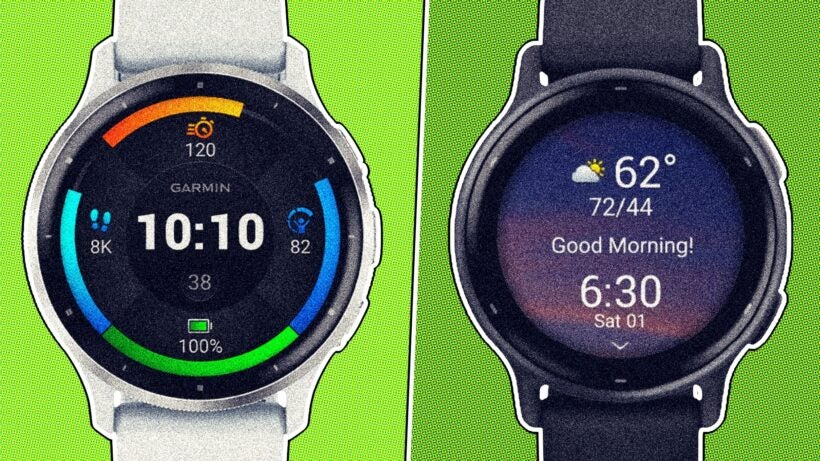Discover the key differences between Garmin's current-gen smartwatches—and which we recommend.
If you’re deciding between the Garmin Venu 3 and the Vivoactive 5, you must consider one crucial factor: whether you can compromise on design quality to save money.
Why? Because the Vivoactive 5 is essentially a cut-price version of the Venu 3.
It makes things confusing, being a completely different Garmin sub-brand yet so close in features to Garmin’s flagship smartwatch. Calling it the Venu 3 Lite would have a more appropriate name.
If you’re in the market for an all-action Garmin smartwatch but you’re struggling to pick between these two, read our guide to choosing the right device for you.
Prices compared
Much of this decision will depend on price, so let’s cut to the chase.
The Garmin Vivoactive 5 is priced at $299/£259 and offers a variety of colors. This presents excellent value for your money. See the latest prices below:
The Venu 3 is priced at $449/£449, indicating that the additional features and improved design come at a significant premium. The company charges a high price for its premium smartwatch. The latest deals are shown below. Keep in mind that it is also available in a smaller Venu 3S design.
What about alternatives? Well, the Forerunner 265 offers most of what these offer, with far more advanced running analytics. The Forerunner 165 is also a great alternative—both will suit those who enjoy more metrics and performance analysis.
Let’s dive into the key differences in features and performance.
1. Design and display

The Venu 3 and Vivoactive 5 appear quite similar, and unless you’re a seasoned Garmin observer, I doubt many people will notice the difference. However, there are a few essential points to understand.
The Vivoactive 5 features an aluminum case, whereas the Venu 3 boasts stainless steel. This difference contributes to a significantly higher quality appearance and feel in the pricier Venu 3.The Venu 3 comes in two sizes. The standard issue is 45mm, but the Venu 3S comes in at 41mm.
The Vivoactive 5 is available in a single 42mm case size, making it a one-size-fits-all option. This may not suit those with larger wrists or anyone who prefers oversized watches, which suggests that the Venu 3 could be the smarter choice.
Both use full AMOLED displays in terms of screen technology. However, there is a big difference in real-world usage. The Vivoactive 5 uses a lower-quality 1.2-inch AMOLED with a 390×390 resolution. The Garmin Venu 3 (45mm) uses a 1.4-inch AMOLED with 454×454, so it’s clear which wins out in this head-to-head.
However, because of the stainless steel case, the Venu 3 weighs 47g with the band, while the Vivoactive 5 weighs 36g, making it more manageable on the wrist.
2. Heart rate tracking performance

One key difference is that the Garmin Venu 3 uses the brand’s Elevate 5 heart rate sensor. That tech was introduced on the new Fenix 7 Pro—essentially, the Venu 3 uses the best Garmin has to offer.
The Vivoactive 5 uses the Elevate 4 sensor. How much difference does it make? It depends on what you’re doing. We’ve found Elevate 4 to be accurate enough for steady runs and workouts and is perfectly good for all-day health tracking. It will do for most people.
However, the newer Elevate 5 sensors have proved more reliable at higher intensities. So, if you want the best, you’ll need to buy the Venu 3.
If you’re particular about your training data, the Venu 3 is best. However, perhaps you should be looking for a more advanced Garmin sports watch—if so, check out our guide to the Venu 3 vs Forerunner 265.
3. Voice features

Garmin has also set aside certain smart features for the Venu 3, and if you wish to make or receive calls, or use your phone’s voice assistant from your wrist, that’s an available option for you.
However, those features don’t feel like a dealbreaker to us.
The Vivoactive 5 still offers payments via Garmin Pay, and you can access Garmin Connect IQ to get apps—which means Spotify playlists on the wrist.
4. ECG, sleep and wellness

Since its launch, Garmin has added its ECG feature (currently only available in certain regions—check our complete Garmin ECG guide for more) to the Venu 3, allowing users to spot-check heart rhythms for signs of atrial fibrillation from the wrist.
Initially, the headline addition to the Venu 3 was the revamped sleep tech, which added a new sleep coach and tracking of naps. We had a few accuracy issues with it in our review time.
Yet, it’s now trickled down to its cheaper sibling, the Vivoactive 5. This means you can get one of the Venu 3’s top selling points for less—and it’s another example of how similar these smartwatches are.
It’s a similar story elsewhere. The Venu 3 and Vivoactive 5 share the same health features, including Body Battery (and insights), Pulse Ox, stress and menstrual tracking, HRV status, and meditation. The only key difference in health features is the lack of Jet Lag Advisor on the Vivoactive 5.
5. Battery life

Regarding battery life, the Vivoactive 5 will last 11 days in smartwatch mode and five days if you use the always-on display (AOD). Meanwhile, using solely the default ‘All Systems GPS tracking’ (more on the available modes in our Garmin GPS guide) will deliver 17 hours.
The Venu 3 will last 14 days in smartwatch mode, dropping to around five days in real-world testing with the AOD enabled. When using the smaller Venu 3S shown above, that AOD time drops to around four days.
You get slightly more out of all-out tracking time, too. The All Systems GPS mode yields 20 hours on the Venu 3. It’s nothing dramatic, but it is a slight boost—and ideal if you’re also streaming music.
Verdict: Which should you choose?
Choose the Garmin Venu 3 if…
The Garmin Venu 3 is the superior smartwatch in every department. If you have an eye on design, it’s a clear choice. Plus, given it’s available in a 41mm or 45mm case, it’s a better choice for those with larger wrists.
Choose the Garmin Vivoactive 5 if…
If you’re looking to save $200/£200 (and let’s face it, who isn’t?) – the Vivoactive 5 offers so much of the Venu 3. All its best features are here, and it’s an excellent all-round, fitness-focused smartwatch.
Side-by-side, it’s visually inferior. However, on its own, it’s a fantastic Garmin all-rounder.




